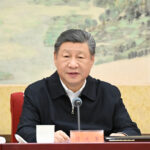China Strengthens Efforts to Stabilize Foreign Investment, Building a Global Investment “Magnet”
Foreign investment serves as a bridge between domestic and international markets, playing a crucial role in building a new development paradigm and promoting high-quality growth.
Despite complex and challenging global economic conditions, China has delivered impressive results in attracting foreign investment—since the start of the 14th Five-Year Plan, cumulative foreign investment has exceeded $700 billion, achieving the target six months ahead of schedule. The number of newly established foreign-invested enterprises has increased by 25,000 compared to the 13th Five-Year Plan period.
Investing in China means investing in the future. Amid deep adjustments in economic globalization, China is building a strong global investment “magnet,” leveraging comprehensive and multi-dimensional strategic advantages to create a thriving environment for multinational corporations.
Increased Foreign Investment Reflects China’s Strong Market Appeal
This year, China has seen significant foreign investment activity: the first wholly foreign-owned tertiary hospital opened in Tianjin, companies like Airbus secured approvals for expanded telecom business pilot programs, and pharmaceutical giants such as Bayer, Pfizer, and AstraZeneca established operations in Beijing’s Biomedical Innovation Park.
Despite global uncertainties, China’s market continues to demonstrate strong “magnetic” appeal:
Data shows that in the first half of the year, 30,014 new foreign-invested enterprises were established nationwide, a year-on-year increase of 11.7%. By the end of June, the total number of newly established foreign-invested enterprises reached 229,000, 25,000 more than during the 13th Five-Year Plan period.
Reports highlight China’s pivotal role in global supply chains and its vast consumer market as key drivers of sustained foreign investment. Many multinational companies describe China as an “ideal, secure, and dynamic” investment destination—a “certain oasis and hotspot for investment.”
China has implemented a series of measures to stabilize foreign investment, including policies to encourage reinvestment by foreign enterprises and streamlined regulations for strategic investments in listed companies.
Experts note that China’s stable economic foundation, diverse advantages, strong resilience, and long-term growth potential remain unchanged. The country’s vast market, efficient industrial and supply chains, and continuously improving innovation environment provide fertile ground for multinational investment.
Optimized Investment Structure: From Manufacturing Hub to Innovation Center
Companies like Amway are deepening their commitment to China, investing billions in upgrading production facilities, digital infrastructure, and customer experience centers. Over the past four years, Amway has achieved an average annual growth rate of 7%, with China being its fastest-growing market.
Foreign enterprises are not only benefiting from China’s market but also actively contributing to high-quality development. Since the 14th Five-Year Plan, China’s foreign investment structure has shifted significantly toward high-tech industries.
In the first half of the year, high-tech industries attracted $127.87 billion in foreign investment, with sectors like e-commerce services, pharmaceuticals, aerospace, and medical equipment seeing growth rates exceeding 50% in some cases. By 2024, high-tech industries accounted for 34.6% of total foreign investment, up 6 percentage points from 2020.
In Shanghai, newly certified multinational regional headquarters and R&D centers highlight the city’s appeal, with major projects in biopharmaceuticals, consumer goods, finance, and emerging sectors like green energy and digital economy.
Reports indicate that R&D spending by multinationals in China surged by 86.5% from 2013 to 2023, reflecting a shift from “market-driven” and “cost-driven” investments to “innovation-driven” collaborations.
Expanding Openness: Policy Measures Yield Results
In Shanghai’s Jinshan District, Lexus’s new electric vehicle and battery R&D project broke ground just two months after signing, showcasing China’s efficient and supportive business environment.
China continues to expand market access, eliminate restrictions in manufacturing, and pilot openings in sectors like telecom and healthcare. Over 500 regulatory documents have been revised or abolished to improve the business climate, while dedicated platforms facilitate communication between foreign investors and government agencies.
At the recent China International Supply Chain Expo, U.S. participation grew by 15%, with 60% of exhibitors being Fortune 500 companies. Investment from ASEAN, Switzerland, Japan, the UK, Germany, and South Korea also saw significant growth in the first half of the year.
China’s commitment to high-level openness promises deeper reforms, high-quality development, and new opportunities for global cooperation and shared success.



